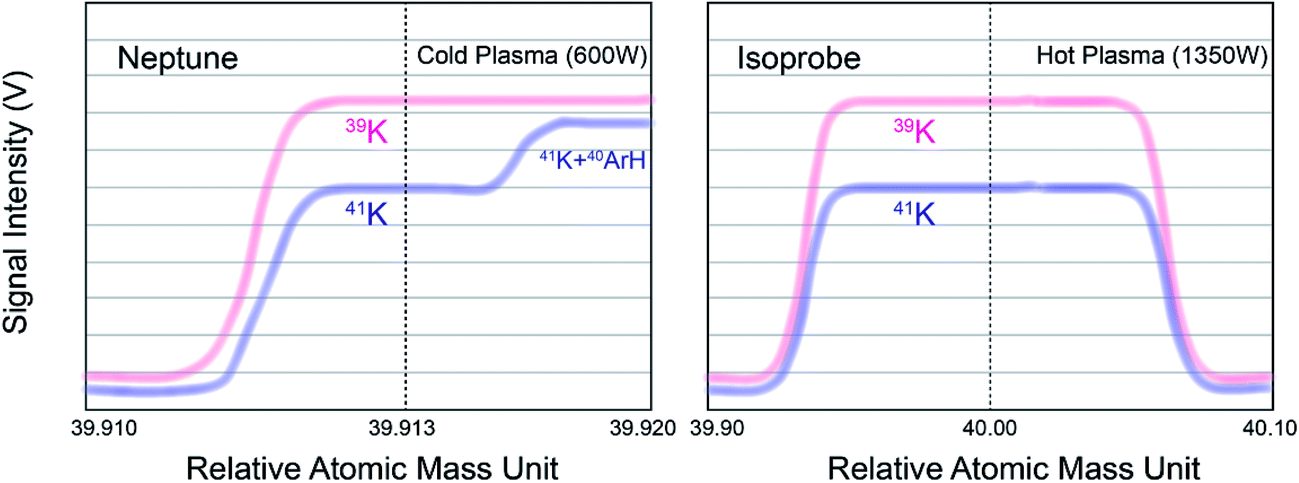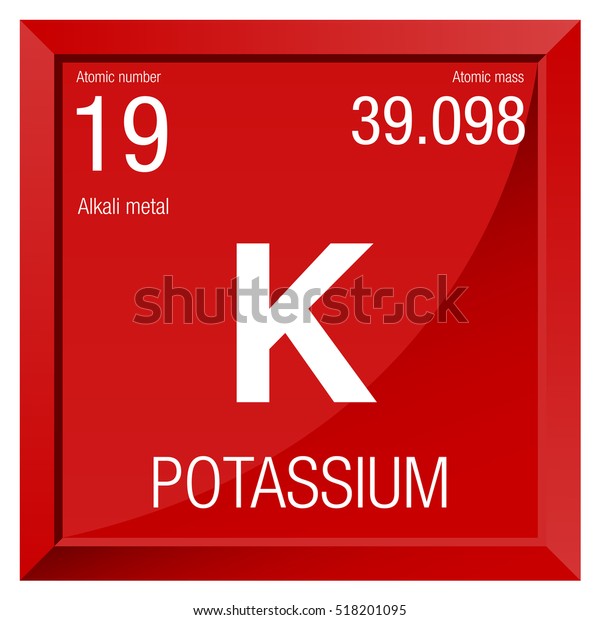By looking at the periodic table we see that potassium reads: 3 9. 0 9 8 3 1 9 K The mass number is the bottom number in this notation so we can see the mass number of potassium is 3 9. Potassium 40 should be at the bottom of this valley and should be the most stable of the nuclei containing 40 nucleons. Its mass energy (or internal energy), however, is actually greater than either of its neighbours – calcium 40 and argon 40. This difference is enough to make potassium 40 unstable. Although Potassium only has two stable isotopes (K-39 and K-41), the long-lived radioisotope K-40 is often also regarded as a stable isotope. Potassium isotopes, mainly K-40 and K-41, are used to study the impact of potassium on the growth of plants and of the human cardiovascular system.
- Potassium Electrons Mass Number
- Atomic Number For Potassium
- What Is Potassium Mass Number
- Potassium 37 Mass Number
Potassium is an alkali metal and was obtained in pure elemental form in 1807 by Hymphry Davy. It is a biologically essential element and also has various industrial applications, including fertilizers, pesticides, explosives etc.
Discovery and History
Potassium was discovered from the ashes of plants and its name was derived from potash (plant ashes). In early days, potassium was extracted by placing ashes of burnt tree in a pot along with water. the mixture was heated and the solution by evaporated to obtain potash (potassium). It was first obtained in pure form by Humphry Davy (1807), through the process of electrolysis. The symbol of potassium is K and is derived from kali (alkali), which is derived from Arabic work for plant ashes (al-qalyah) [1].
Potassium
| Periodic Table Classification | Group 1 Period 4 |
|---|---|
| State at 20C | Solid |
| Color | Silvery-gray |
| Electron Configuration | [Ar] 4s1 |
| Electron Number | 19 |
| Proton Number | 19 |
| Electron Shell | 2, 8, 8, 1 |
| Density | 0.86 g.cm-3 at 20°C |
| Atomic number | 19 |
| Atomic Mass | 39.10 g.mol -1 |
| Electronegativity according to Pauling | 0.82 |
Occurrence
Potassium occurs in nature in the form of ionic salts. In ratio of abundance, it is the 20th most abundant element in the solar system and 17th most abundant on the earth (makes around 2.6% of weight of the earth’s crust). It is also found in dissolved form in sea water and constitute about 0.04% potassium by weight [2]. It has a low first ionization energy (418.8 kL/mol). Potassium is also present in Supernovae environment and produced through explosive oxygen-burning process. In human body, potassium constitutes about 0.2% by mass and is about the 8th most abundant element of human biological system. It is a major component of variety of proteins and enzymes. Potassium is also present in fruits (high concentrations in bananas, avocadoes), vegetables (potatoes, tomatoes, beet green, white beans), fish and meat.
Potassium Electrons Mass Number
Physical Characteristics
Potassium is silvery-white, soft metal with second least density (0.89 g/cm3). At standard conditions, potassium can be cut with a knife. Potassium undergoes tarnishing when exposed to air and oxygen. Potassium can float on water. It has a boiling point of 770 °C and melting point of 63 °C. It belongs to Group 1 (1A) of periodic table. Potassium gives a vigorous reaction with water (forming potassium hydroxide) and burns with a pale violet color.
Please enter a valid email address. Password must be at least 6 characters. Devslopes brings guided learning in the most effective, engaging, and fun way possible. Videos & Source Code All access to our videos and source code. We regularly maintain all our content so you’re always up to date. The final week of the program is an intensive 150 question exam. When you pass this exam you will receive an official Devslopes Certification. You will also now be ready to take the official Associate Android Developer or Official Swift certification exams. Devslopes academy cost.
Chemical Characteristics


Potassium has one valence electron, that is readily lost to acquire a positive charge. Potassium is one of the alkali metals and it can combine with anions to from salts. It is very reactive and is rapidly oxidized when exposed to air forming potassium peroxide. Potassium gives a vigorous reaction with water (forming potassium hydroxide) and burns with a pale violet color. Potassium does not react with hydrocarbons (kerosene or mineral oil). Potassium is a powerful reducing agent and is highly stable in its oxidized form [3]. With water, potassium forms a strong alkali (KOH). The compounds of potassium are highly ionic and have high solubility.
Significance and Uses
- It is widely used in fertilizers. It is the largest industrial usage of potassium and about 90% of potassium produced in the world is utilized in the production of various fertilizers.
- It is a commonly used food additive and is main component of baking powder and silvering mirrors.
- Potassium chromate is a widely used pigment and is part of dyes, inks, stains etc.
- Potassium is used in leather tanning industries.
- It is used to make fireworks, matches and explosives (Potassium chlorate).
- Potassium carbonate, usually termed as potash is widely used in the manufacturing of soap, glass, fluorescent lamps, fire extinguishers, and color TV.
- Potassium bromide is used as a sedative.
- It is used as a heat exchange material, in nuclear power generating plants.
- Potassium is also used in making insecticides and pesticides.
Health Hazards
Potassium is an essential nutrient and human body requires a balanced supply (about 3.3 gram daily) of potassium. Deficiency of potassium can lead to hypokalemia and hypertension [4]. The reaction of potassium with water is highly exothermic and splashes can lead to skin burns and damage. It reacts explosively with sulphur acid, so special care is required during handling of potassium.
Isotopes of Potassium
There are about two dozen isotopes of potassium, and three of them occur naturally (39K, 40K and 41K). 40K is the radioactive isotope. It is present in human body in great abundance and around 4,400 nuclei of 40K decay per second occur in an average human body. 40K provides the largest source of natural radioactivity and used widely for rock dating. 39K is the most common isotope and constitute around 93.3 % of potassium isotopes [5].
Atomic Number For Potassium
REFERENCES

[1] http://www.chemistryexplained.com/elements/L-P/Potassium.html
[2] Webb, D. A. (April 1939). “The Sodium and Potassium Content of Sea Water” (PDF). The Journal of Experimental Biology (2): 183.
[3] Dye, J. L. (1979). “Compounds of Alkali Metal Anions”. Angewandte Chemie International Edition. 18 (8): 587–598. doi:10.1002/anie.197905871
[4]. Whelton PK, He J, Cutler JA, Brancati FL, Appel LJ, Follmann D, Klag MJ (1997). “Effects of oral potassium on blood pressure. Meta-analysis of randomized controlled clinical trials”. JAMA. 277 (20): 1624–32. doi:10.1001/jama.1997.03540440058033. PMID9168293.
[5] “Radiation and Radioactive Decay. Radioactive Human Body”. Harvard Natural Sciences Lecture Demonstrations. Retrieved July 2, 2016
What Is Potassium Mass Number
Other Periodic Table Elements
Potassium 37 Mass Number
- Rubidium
Rubidium was discovered in 1861. It belongs to the alkali metals group of the periodic…
- Dysprosium
Dysprosium was discovered in 1886. It is used to make control rods in nuclear reactors…
- Francium
Francium was discovered in 1939. It is very unstable alkali metal and considered the second…
